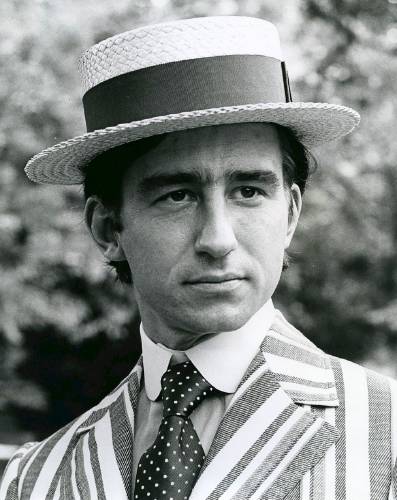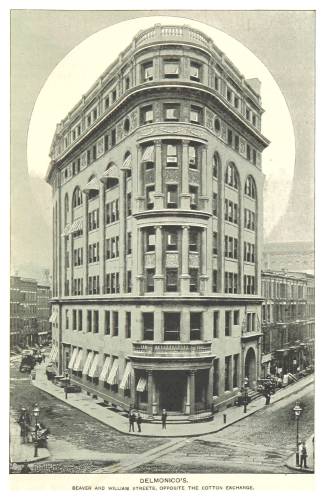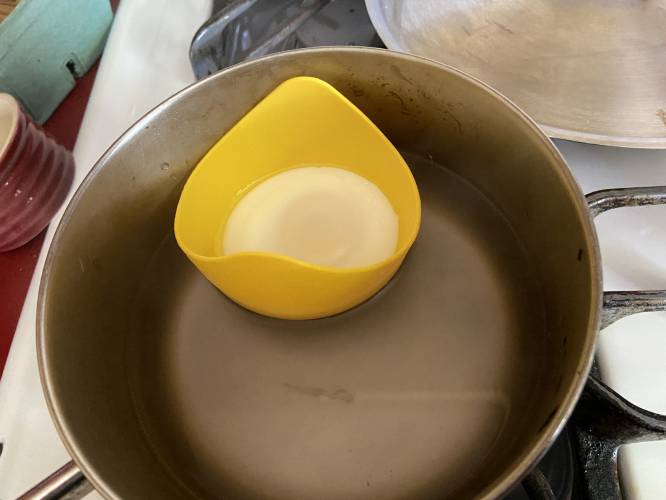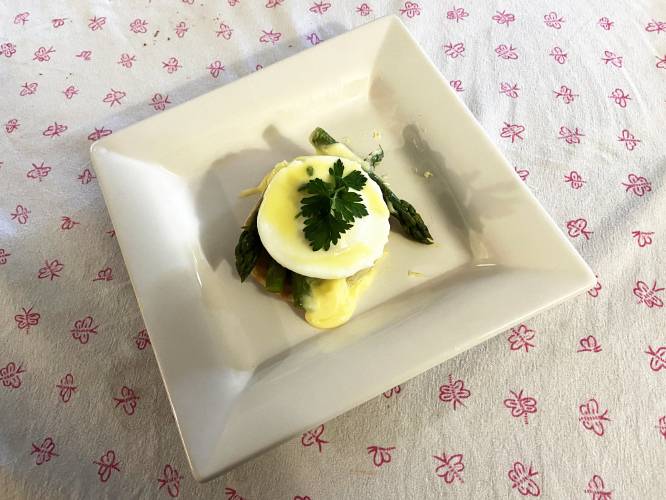In asparagus season, try Eggs Beatrice: The story behind one of the most popular brunch dishes
| Published: 05-19-2025 10:55 AM |
Many people (and restaurants) contemplating brunch turn to Eggs Benedict.
As with many recipes, the origin of this dish is hard to pin down. My favorite story (because it involves a woman) traces it to Delmonico’s Restaurant in New York City, a dining institution that has been in existence since the 1820s.
It served myriad politicians and celebrities in the 19th century, among them singer Jenny Lind, President Abraham Lincoln, humorist Mark Twain, England’s Edward VII when he was prince of Wales, and industrialist Diamond Jim Brady. (The New York Times dubbed Brady “the foremost eater of the Gilded Age.”)
In the 20th century, diners at Delmonico’s included crooner Frank Sinatra, actress Marilyn Monroe, President John F. Kennedy, and Kennedy’s widow Jacqueline Onassis.
According to the Delmonico’s myth, Mrs. Legrand Benedict, a regular eater at the restaurant in the 1860s, asked Chef Charles Ranhofer to make her something new for lunch as she had tired of his regular menu.
Ranhofer came up with an egg-ham-Hollandaise concoction and promptly put it on the regular menu, naming it after Benedict.
Another origin story involves another famed New York chef, Oscar Tschirky, known as Oscar of the Waldorf, during his long tenure at the Waldorf Hotel.
In the 1890s, legend has it, stockbroker Lemuel Benedict wandered into the Waldorf one morning in search of a cure for a substantial hangover. He asked Tschirky to make him a dish with eggs, bacon, and Hollandaise sauce. The chef played with the dish and put it on the Waldorf menu.
Article continues after...
Yesterday's Most Read Articles
I love stories about food, but in the end I don’t think it really matters whether either of these Benedicts (or another; I saw Benedict Arnold mentioned once in this context!) inspired the dish so many Americans love. In the final analysis, food is prized for its flavor rather than its originality.
I do believe that my own riff on Eggs Benedict may be original, however, or as original as any recipe based on another can be.
I have never really taken to Eggs Benedict. I love eggs, English muffins, and Hollandaise sauce. It’s the ham or Canadian bacon that doesn’t sit quite right with me. I don’t think it adds anything to the dish in terms of either flavor or consistency.
Consequently, about 15 years ago, I invented my own version of the dish. In the place of the ham/bacon, I used one of my favorite foods at this time of year (or at any time of year): asparagus.
I obviously wasn’t the first person to combine asparagus with Hollandaise sauce. That pairing has been popular at least since the 1600s, when the French chef François Pierre de la Varenne invented Hollandaise and dolloped it on some green spears. I think the English muffin addition is my own, however.
Reluctant to use the name Benedict since I had changed the recipe, I dubbed the dish Eggs Beatrice in a sort of nod to Benedict. In Shakespeare’s “Much Ado About Nothing,” heroine Beatrice and hero Benedict spar with each other … until they finally admit that they are in love.
Like so many of Shakespeare’s plays, “Much Ado” is a precursor to other screwball comedies in different media, from Jane Austen’s novel “Pride and Prejudice” to the black-and-white classic films of the 1930s like “It Happened One Night.”
My parents took me to see “Much Ado” in New York when I was a child. I was enchanted by the play and by its male star, Sam Waterston, now an elder of American stage and screen but then an engaging relatively young man.
So here is the recipe for Eggs Beatrice. Some people have trouble poaching eggs; I am one of them. Somehow, even when I use all the tricks I have been taught (add a little vinegar to the water, gently stir the water as it boils), my eggs emerge from the pan less than perfectly poached.
I get around this difficulty in two ways. First, I show no fear in the kitchen. I truly believe that food knows when you’re afraid of it and consequently acts up.
Second, I cheat. I poach my eggs using handy little silicone cups that hold them together in the boiling water. To use one of these silicone products, lightly oil the inside, pop your egg into it, and float the eggshell in a pot of boiling water.
Cover the pot, and cook for 5 minutes. Your poached egg pops easily out of the silicone (be sure to drain off any water that has crept into the silicone) and onto your English muffin.
If you’re comfortable poaching your eggs without this handy gadget, I applaud you, but I like to cheat a little. And the silicone cups are dishwasher safe.
Enjoy your eggs … and your fabulous local asparagus!
Ingredients:
for the Hollandaise sauce (makes about 1 cup of sauce):
1/2 cup (1 stick) sweet butter
3 egg yolks
the juice of 1/2 small lemon
2 tablespoons hot water
a pinch of cayenne pepper
a pinch of salt
for assembly (per person):
1/2 English muffin
butter as needed for the muffins
3 spears cooked asparagus (either whole or cut up; halved works for me)
1 poached egg
a generous dollop of Hollandaise sauce
salt and pepper to taste
Instructions:
First, make the Hollandaise sauce. Melt the butter in a saucepan. In the top of a double boiler over warm (but not boiling!) water, whisk the egg yolks until they are smooth. Whisk in the lemon juice.
Slowly whisk in the butter in a thin stream; then slowly stir in the hot water, cayenne, and salt, and cook for 1 minute more, whisking constantly. Set the sauce aside while you poach the eggs and cook the toast.
For each person, butter half a toasted English muffin. Depending on your preference, put the asparagus on first or the egg. (I like it both ways!)
Cover with sauce, and season to taste. Serve immediately. One recipe of Hollandaise makes enough sauce for 4 to 6 eggs. Leftover sauce may be kept in the refrigerator for a few days. (If the sauce curdles, gently and slowly whisk in a small amount of hot water.)
Tinky Weisblat is an award-winning cookbook author and singer known as the Diva of Deliciousness. Visit her website, TinkyCooks.com.










 ‘I’ve met friends in my books’: Eric Carle Museum celebrates author, illustrator Grace Lin with retrospective exhibition
‘I’ve met friends in my books’: Eric Carle Museum celebrates author, illustrator Grace Lin with retrospective exhibition ‘You can just do it forever’: Belly dance classes and shows grow steady local following
‘You can just do it forever’: Belly dance classes and shows grow steady local following With a little help from his community: Northfield Mount Hermon teacher fighting rare form of cancer begins clinical trial
With a little help from his community: Northfield Mount Hermon teacher fighting rare form of cancer begins clinical trial Valley Bounty: Rain or shine, strawberries are here: Teddy C. Smiarowski Farm welcomes another pick-your-own season
Valley Bounty: Rain or shine, strawberries are here: Teddy C. Smiarowski Farm welcomes another pick-your-own season
